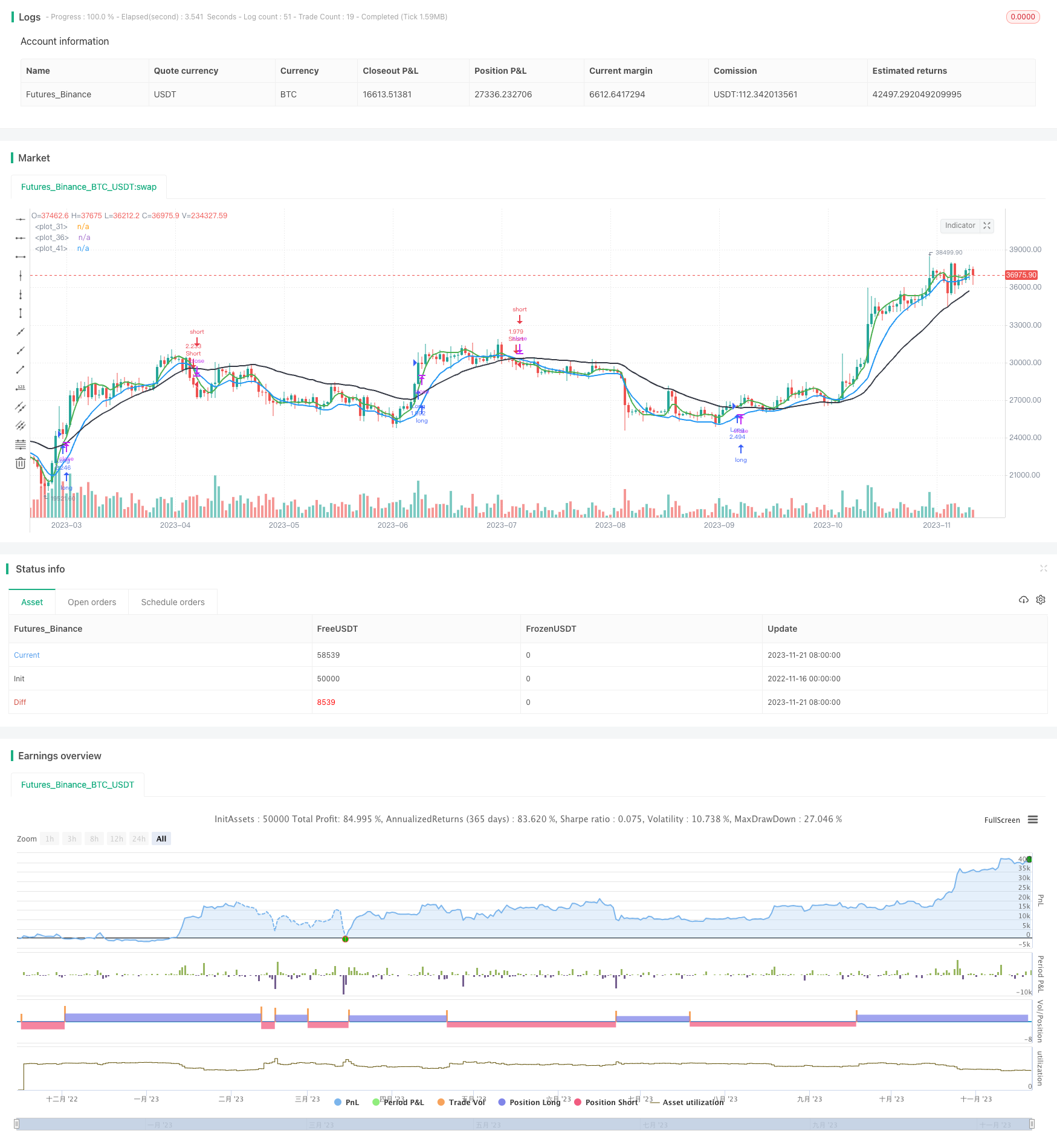
概述
双指数移动平均线交叉策略(Dual Exponential Moving Average Crossover Strategy)是一种典型的趋势跟踪策略。它利用不同参数的双指数移动平均线的金叉和死叉来判断行情趋势,并相应做多做空。
策略原理
该策略同时使用3条不同参数的双指数移动平均线:DEMA(8)、DEMA(20)和 DEMA(63)。其中:
- DEMA(8)反应最快,用于捕捉短期趋势;
- DEMA(20)速度稍慢,用于识别中期趋势;
- DEMA(63)反应最慢,用于判断长期趋势方向。
当快线DEMA(8)上穿中线DEMA(20)和慢线DEMA(63)时,表示行情由下向上反转,做多;当快线DEMA(8)下穿中线DEMA(20)和慢线 DEMA(63)时,表示行情由上向下反转,做空。
优势分析
相比单一移动平均线,双指数移动平均线对价格变化更为敏感,可以更早发现趋势转折点。该策略综合多个时间段双指数线,能够有效跟踪市场趋势方向。
多时间段DEM线组合,提高了交易信号质量,避免了假突破。同时,策略只在三条线发生交叉时才产生信号,避免过于频繁交易。
风险分析
该策略主要面临以下风险:
- 三条线交叉信号较少,容易漏过部分交易机会;
- 行情剧烈波动时,DEM线交叉延迟,无法及时反应价格变化;
- 无法有效应对特大的非趋势性行情。
可通过优化移动平均线参数、添加过滤条件等方式进一步改进和控制风险。
优化方向
该策略可从以下几个方面进行优化:
- 优化移动平均线参数,使其更符合不同市场的特点;
- 增加成交量、波动率等过滤条件,避免错误信号;
- 结合其他指标过滤假信号,例如MACD、KDJ等;
- 增加止损策略,控制单笔亏损;
- 优化仓位管理,让盈利比例大于亏损比例。
总结
双指数移动平均线交叉策略整体思路清晰,通过多时间段DEM的组合使用,有效判断市场趋势方向,是一种典型的趋势跟踪策略。该策略可根据实际需要,通过参数优化、增加过滤条件、止损管理等方式进行改进,从而获得更好的策略效果。
策略源码
/*backtest
start: 2022-11-16 00:00:00
end: 2023-11-22 00:00:00
period: 1d
basePeriod: 1h
exchanges: [{"eid":"Futures_Binance","currency":"BTC_USDT"}]
*/
// This source code is subject to the terms of the Mozilla Public License 2.0 at https://mozilla.org/MPL/2.0/
// © Noldo
//@version=4
//Quoted by Author HighProfit
//Lead-In
strategy("Double Exponential Moving Average 8-20-63 Strategy",
shorttitle="DEMA-8-20-63",
overlay=true,
max_bars_back = 5000,
initial_capital=100000,
max_bars_back = 5000,
default_qty_type=strategy.percent_of_equity,
default_qty_value=100,
commission_type=strategy.commission.percent,
commission_value=0.1,
pyramiding = 0)
short = input(8, minval=1)
srcShort = input(ohlc4, title="Source Dema 1")
long = input(20, minval=1)
srcLong = input(low, title="Source Dema 2")
long2 = input(63, minval=1)
srcLong2 = input(close, title="Source Dema 3")
e1 = ema(srcShort, short)
e2 = ema(e1, short)
dema1 = 2 * e1 - e2
plot(dema1, color=color.green, linewidth=2)
e3 = ema(srcLong, long)
e4 = ema(e3, long)
dema2 = 2 * e3 - e4
plot(dema2, color=color.blue, linewidth=2)
e5 = ema(srcLong2, long2)
e6 = ema(e5, long2)
dema3 = 2 * e5 - e6
plot(dema3, color=color.black, linewidth=2)
longC = dema1 > dema2 and dema1 > dema3
shortC = dema1 < dema2 and dema1 < dema3
alertlong = longC and not longC[1]
alertshort = shortC and not shortC[1]
strategy.entry("Long" , strategy.long , when = longC ,comment="Long")
strategy.entry("Short", strategy.short, when = shortC,comment="Short")
// Alerts
alertcondition(longC , title='Long' , message=' Buy Signal ')
alertcondition(shortC , title='Short', message=' Sell Signal ')